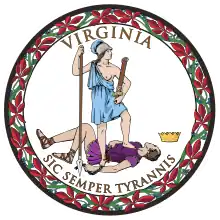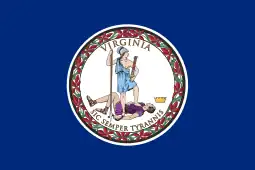Outline of Virginia
The following outline is provided as an overview of and topical guide to the U.S. state of Virginia:


Virginia (officially, the Commonwealth of Virginia) – U.S. state located in the South Atlantic region of the United States. Virginia is nicknamed the "Old Dominion" due to its status as a former dominion of the English Crown,[1] and "Mother of Presidents" due to the most U.S. presidents having been born there. The geography and climate of the Commonwealth are shaped by the Blue Ridge Mountains and the Chesapeake Bay, which provide habitat for much of its flora and fauna. The capital of the Commonwealth is Richmond; Virginia Beach is the most populous city, and Fairfax County is the most populous political subdivision. The Commonwealth's estimated population as of 2013 is over 8.2 million.
General reference

- Names
- Common name: Virginia
- Pronunciation: /vərˈdʒɪniə/ ⓘ
- Official name: Commonwealth of Virginia
- Abbreviations and name codes
- Nicknames
- Mother of Presidents
- The Old Dominion[2]
- The Commonwealth
- Common name: Virginia
- Adjectivals: Virginia, Virginian
- Demonym: Virginian
Geography of Virginia
- Virginia is: a U.S. state, a federal state of the United States of America
- Location
- Population of Virginia: 8,001,024 (2010 U.S. Census[3])
- Area of Virginia:
- Atlas of Virginia
Places in Virginia
- Historic places in Virginia
- National Natural Landmarks in Virginia
- National parks in Virginia
- State parks in Virginia
Environment of Virginia
- Climate of Virginia
- Protected areas in Virginia
- Superfund sites in Virginia
Natural geographic features of Virginia
Regions of Virginia
Administrative divisions of Virginia

- The 95 Counties and 38 Cities of the Commonwealth of Virginia
- Municipalities in Virginia
Demography of Virginia
Government and politics of Virginia
- Form of government: U.S. state government
- United States congressional delegations from Virginia
- Virginia State Capitol
- Elections in Virginia
- Political party strength in Virginia
Branches of the government of Virginia
Executive branch of the government of Virginia
Legislative branch of the government of Virginia
Law and order in Virginia
Military in Virginia
Local government in Virginia
History of Virginia
History of Virginia, by period
- Prehistory of Virginia
- English Colony of Virginia, 1584–1707
- Roanoke Colony, 1585–1587
- Jamestown, Virginia, 1607–1760
- History of slavery in Virginia
- Middle Plantation, Virginia, since 1632 (Williamsburg since 1698)
- French colony of Louisiane, 1699–1764
- British Colony of Virginia, 1707–1776
- French and Indian War, 1754–1763
- British Indian Reserve, 1763–1783
- American Revolutionary War, 1775–1783
- Commonwealth of Virginia since 1776
- Cherokee–American wars, 1776–1794
- First state to ratify the Articles of Confederation and Perpetual Union, signed July 9, 1778
- Northwestern territorial claims ceded 1784
- Tenth state to ratify the Constitution of the United States of America on June 25, 1788
- George Washington becomes the first President of the United States on April 30, 1789
- Separation of the Commonwealth of Kentucky, 1792
- Thomas Jefferson becomes the third President of the United States on March 4, 1801
- James Madison becomes the fourth President of the United States on March 4, 1809
- War of 1812, 1812–1815
- Treaty of Ghent, December 24, 1814
- James Monroe becomes the fifth President of the United States on March 4, 1817
- William Henry Harrison becomes ninth President of the United States on March 4, 1841
- John Tyler becomes the tenth President of the United States on April 4, 1841
- Mexican–American War, April 25, 1846 – February 2, 1848
- Zachary Taylor becomes 12th President of the United States on March 4, 1849
- Virginia in the American Civil War, 1861–1865
- Confederate States of America, 1861–1865
- Eighth state to declare secession from the United States on April 17, 1861
- Eighth state admitted to the Confederate States of America on May 7, 1861
- Manassas Campaign, July 2–21, 1861
- First Battle of Bull Run, July 21, 1861
- Battle of Hampton Roads, March 8–9, 1862
- Valley Campaign, March 23 – June 9, 1862
- Peninsula Campaign, March – July 1862
- Battle of Seven Pines, May 31 – June 1, 1862
- Seven Days Battles, June 25 – July 1, 1862
- Northern Virginia Campaign, July 19 – September 1, 1862
- Second Battle of Bull Run, August 29–30, 1862
- Battle of Fredericksburg, December 11–15, 1862
- Battle of Chancellorsville, May 1–4, 1863
- Separation of the State of West Virginia, 1863
- Bristoe Campaign, October 14 – November 9, 1863
- Overland Campaign, May 5 – June 24, 1864
- Battle of the Wilderness, May 5–7, 1864
- Battle of Spotsylvania Court House, May 8–21, 1864
- Battle of Cold Harbor, May 31 – June 12, 1864
- Valley Campaigns, May 15 – October 19, 1864
- Bermuda Hundred Campaign, May 6–20, 1864
- Siege of Petersburg, June 9, 1864 – March 25, 1865
- Appomattox Campaign, March 29 – April 9, 1865
- Battle of Five Forks, April 1, 1865
- Battle of Appomattox Court House, April 9, 1865
- Confederate States of America, 1861–1865
- Virginia in Reconstruction, 1865–1870
- Eighth former Confederate state readmitted to the United States on January 26, 1870
- Woodrow Wilson becomes 28th President of the United States on March 4, 1913
- Shenandoah National Park established on December 26, 1935
Culture of Virginia
The arts in Virginia
Economy and infrastructure of Virginia
- Communications in Virginia
- Health care in Virginia
- Transportation in Virginia
- Airports in Virginia
- Roads in Virginia
Education in Virginia
See also
- Virginia
- Index of Virginia-related articles
- All pages with titles beginning with Virginia
- All pages with titles containing Virginia
References
- "Old Dominion". Encyclopedia Virginia.
- Barry Popik, Smoky City, barrypopik.com website, March 27, 2005
- "U.S. Census Bureau State & County QuickFacts Virginia". Archived from the original on 2012-08-02. Retrieved 2011-11-18.
